Mary Mattingly has a passion for water and food, and that may count as a very New York thing. Hers is rooted in different places, as I – and you – will learn later. Mary is a visual artist whose work has been shown in places like New Zealand, Cuba, or Canada. New York, however, is the place she chose when she planted a garden on a boat for everyone to visit – and pick what you’d like to eat.
The first time I saw this floating garden called Swale, it was closed. I hadn’t expected the heavy rainstorm that came down in Brooklyn Bridge Park just when I reached the gate and noticed it was locked. So the leaves and flowers and fruit stayed out of my reach, but we got drenched all the same.
Today, however, the sun is out for my visit, children in Concrete Plant Park toss me a ball on my way to the Bronx River bank, their parents laying out food for a picnic. But it seems like everytime I visit Swale, something out of the ordinary is about to happen.
This time, the crew of another boat asks if they can tie up at the barge. “Of course”, says Mary. The men work on one of the Department of Environmental Protection’s vessels that once a week clears the Bronx River of debris. After an unexpected delay, the tide had changed, so they have to wait for the water to rise before they can go back. I couldn’t think of a better reminder that I am, in fact, on the water.
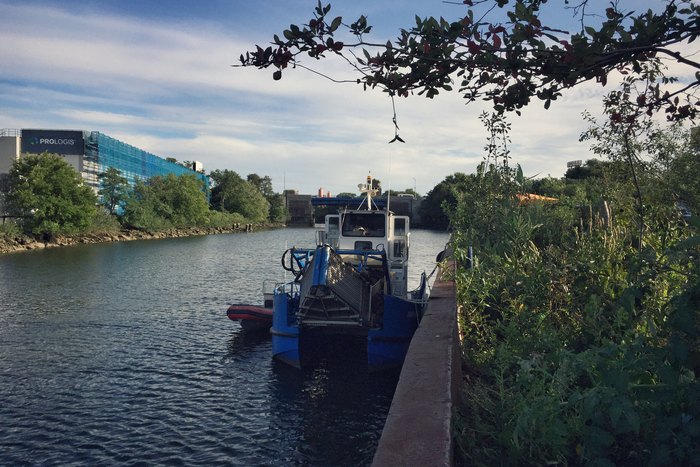
The bow of the smaller boat on the left is designed to pick up debris like tree logs, tires, plastic and other waste from New York waterways. That’s an ongoing work done by the Department of Environmental Protection.
Meanwhile, I pick and taste a leaf. “This one”, says Mary while I chew, “is really good for your liver.” We think of the cocktails that could challenge its effect. Then I take time to smell a flower, eat a berry in this place that Mary calls a food forest.
And yes, that sounds like a hippie-meets-hipster-kind of thing. Nice to have, nice to look at, designed to feel good about yourself, an eco-friendly paradise for a chosen few (mind the apples, kids!). In reality, this 130 by 40 foot barge floats an idea much, much bigger than a garden – and tied to an embarrassing NYC problem: In a city as rich as this, the people in several neighborhoods lack access to fresh food. And you can live on potato chips only for so long.
So let’s learn from Mary Mattingly what it took to create a barge carrying edible plants, why she didn’t do this on land, what this little project may mean for New York’s future, and also: what art’s got to do with it.
Mary, what is a food forest?
Mary Mattingly: A food forest is a kind of perennial planting. The term comes from permaculture, it is trying to evoke a forest where everything is edible. In this case, everything in the forest is either edible, medicinal, or a pollinator. Our hope was that people would come on board and pick food for free, and that it would inspire land-based spaces like this. Because Swale is a barge on the water. It was previously used for hauling sand to construction sites. A barge like this probably brought sand to be made into concrete at this space here, Concrete Plant Park, which used to be industrial.
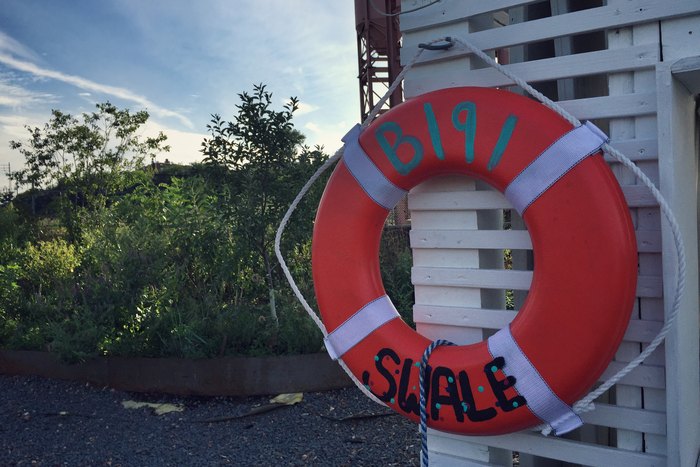
Why is your garden of free food on a barge?
There are a few reasons that we did it on the water. One is just because we can move from place to place, so we are able to show the idea in different places. But the main reason is because the public laws of the water are different than the public land laws here. Swale is on the water because we wanted to make a public space where people could pick food for free. That doesn’t really exist on public land in New York City, because of rules that have existed since the Olmstead design: Picking anything on public land, including plants, constitutes destruction of property. That rule makes sense when you think about what could happen if everyone picked all the plants: There would be no plants.
But sometimes rules that are made to preserve nature or save it from destruction can turn out to be a problem.
I talked to people in the Parks Department whose reasoning for the conservation that is currently done is: People appreciate biodiversity in parks in New York City. Their conservation process includes putting a lot of effort into keeping the parks’ spaces more biodiverse, because otherwise, certain plants will take over. The parks’ staff have to use weed killers, to put toxins on the soil and plants in order to preserve the aesthetics of the parks. We don’t have to take that away, but we would like to think creatively about how that pruning can happen. If we were allowed to forage certain plants from New York public parks, these plants wouldn’t be overgrowing. As food, they would also provide for a very big need.
But then again, as you said: If everybody did that, nothing would grow anymore. Do you have any idea how that could be approached?
We are thinking of a commons model with stewards, where people are looking out for the spaces as well as gaining resources from them. There is a limit to how much and what people can pick for this to work. When that limit is exceeding, the more people are at the table, the more people will step up and say: “Stop, we want this for next year.” It is sort of like the fishing industry. There aren’t that many companies involved in the fishing industry. But imagine if many more of us could be on the water fishing. There would be more protest about how much is being fished. Swale can be a proposal for what could happen on land. And we also are able to illustrate and demonstrate that this has a use and there is a desire for something like this and for more spaces to exist like this. In the city, it could be advantageous in a lot of different ways.
You are not a biologist by trade. How did you get all the necessary knowledge to make Swale happen?
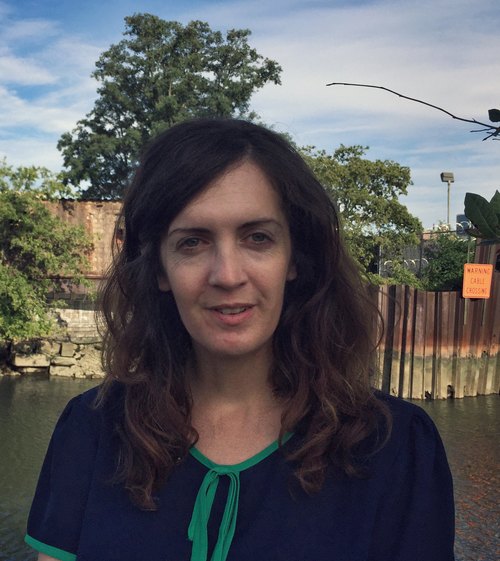
Mary Mattingly
is an artist and organizer,
was born in Rockville, CT and raised in Somerville, CT,
moved to NYC in August 2001,
currently lives in Gowanus (Brooklyn),
previously lived entirely off the food grown on a barge for six month, together with a group of artists and scientists in a project called “Waterpod”.
You know, a lot of this was trial and error. For example, we wanted to build this hill this year, and we didn’t find anyone who had built a hill on a barge before (laughs). So we talked with the engineer who built the hills on Governors Island and to a naval engineer and kind of put that knowledge together. That’s how we have done a lot of these things. And we start with the materials. Especially in a city that includes the former landfill Fresh Kills – a human made piece of infrastructure so large that you can see it from space – a significant question is: What are our local resources? What can be easily accessed locally, what is in the waste stream, what is underused or can be repurposed? So we try to avoid bringing things in, whether we make a water filtration system or garden beds or create drainage underneath. I think that can lead to the larger point of thinking: If we are producing more of our food right inside of the city, then we are less a draw on the outside. And that really links up to my background of growing up in an agricultural town where a lof of what we made would go into the city and a lot of the garbage would come back out.
Even though you weren’t raised on the water, many of your projects involve water. What draws you to it?
What drew me to the water initially was living in an agricultural community and understanding how chemicals that we use on plants affect our water source. Secondly, that area would always flood. So it was a combination of knowing the dangers of water and also the necessity of it first hand. I specifically remember when Bechtel privatized water in Bolivia in the year 2000. That meant that some people weren’t going to be able to afford water. It angered me that it suddenly became a life-or-death-struggle to get something that is so essential as well as plentiful and that should be healthy and free. Then I realized that anger came from love. I was really committed to water as a space to begin from and to try to empower it as a subject, and for me, that was working through art. There are multiple ways to do this. I could make sculptures that were really water purifiers or I could tell stories through photographs or create a space that would serve as a living story or stage. That’s how I think about Swale. It is a platform where you can talk about food and the necessity of it being availabe and accessible.
You’ve been sailing this message to different parts of the city, like Brooklyn Bridge Park or Governors Island. How do you get to dock anywhere?
Each pier has a separate permitting process, and it doesn’t stop there. The city has its own regulation and permitting process, the Parks Department has another one, and the waterways, with the Coast Guard as one of the main parties. We also must have a permit from the Department of Environmental Protection (DEP) and several state organizations. To stay permanently docked in one place would require even more of this. Even if a city-wide organization takes Swale on, we will still have to think about the state and national permits required.
Sounds like a lot of work.
Yeah, but they are all stewards in a way. There is a reason for this.
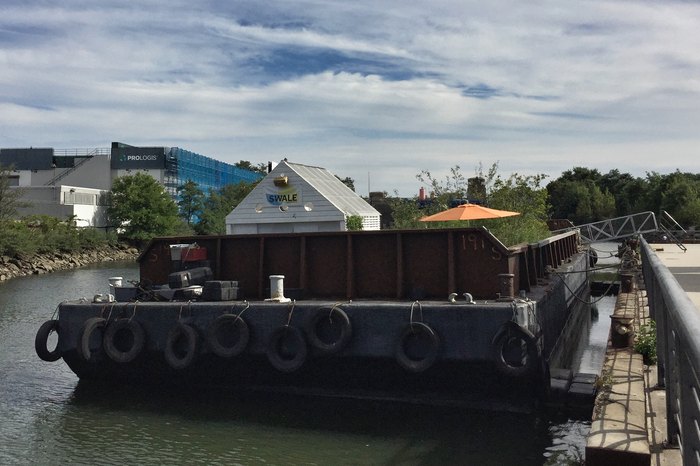
Sure, you don’t want eight million barges trying to dock in the city or blocking the waterways. Talking about boats: Do you see any, is there traffic up here on the Bronx River?
Yes. Rocking The Boat is an organization that has kayaks and makes trips about once a week, and there are a lot of smaller boats on the water, mostly for recreation.
Any motor boats?
No. Except for the DEP boat taking debris out of the river.
Where is Swale going in the winter?
It will go to Peekskill, back to where we rented it from. And then we will put burlap over the new trees and just let everything hibernate. In an ideal world we would probably greenhouse part of it and continue programming in the winter and keep it at a public pier, but not right now. That is an economic question.
How do you decide what to plant on Swale?
There are four people on our team who work with plants specifically. And we did a lot of outreach to local farms, from Pennsylvania to New York to Connecticut and New Jersey, especially ones who are focusing on permacultural crops, those that are edible and also perennial. We also talked to the Parks Department about which plants their nurseries are growing. We work with them very closely to get a lot of the edible plants they have, so we can demonstrate how they can work in a food forest scenario. Again, it’s like the hill, where we are cobbling together different knowledge sets and asking experts. Luckily we have some on our team as well (laughs).
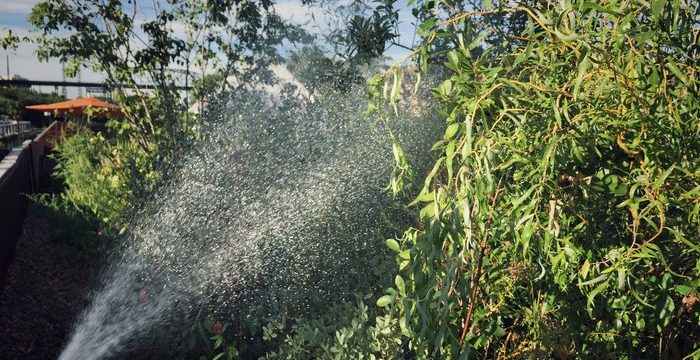
Have you always worked that way that you are aware of what you don’t know and are open to ask others?
I think so. That’s how it’s always been for me. As a working artist, it was frustrating me how alone we were expected to work. Even though it is common knowledge that when we work together collaborately, we learn so much more, and we can do something larger than what we can do by ourselves. Obviously this project would have not existed if there was one person doing it. Also, before we go to a place, we see who is involved there, what the stewardship could be like. So before we came to Concrete Plant Park, that was when I initiated a self-sufficient ecosystem project called “Water Pod” with a group of engineers, artists, ecologists and scientists, we met organizations like the Bronx River Alliance, Rocking The Boat, The Point and Youth Ministries for Peace and Justice (YMPJ). At the time, we were growing vegetables. And the person who was running YMPJ at the time, Julian Terrell, said to me: “You guys spend of lot of your time gardening, and you know, if you had perennial plants, it would be so much easier.” (laughs) And it really comes alive when people come on board and tell us for which recipes they use certain plants. That increases our knowledge that we can share with someone else. Working with all kinds of people and organizations also means it’s building upon its own momentum, but it’s spreading as well. And now the Food Way is happening.
What is the Food Way?
After we came to Concrete Plant Park in the Bronx last year, the Parks Department considered doing something on land as a pilot. So this year, they have broken ground behind us, and they are planting some perennial, edible plants. This is a start. They are going to use it as an educational space, but they might eventually open it up so anyone can pick food there.
For now, food is a private issue. If you have money, you can buy healthy food, if you don’t – well … Is this part of your motivation to inspire change?
Healthy, fresh food should not be commodified. It should be like water. When this kind of infrastructure is privatized, we are killing people. People are dying from the way that certain food is made and from not having access to food. So we need to push the dial far into the other direction. Healthy, fresh food should be available, and it should be free. It also should be on our public lands, because providing food is a public service and it needs to be promoted as one. We need to remind ourselves that we actually need healthy food to live.
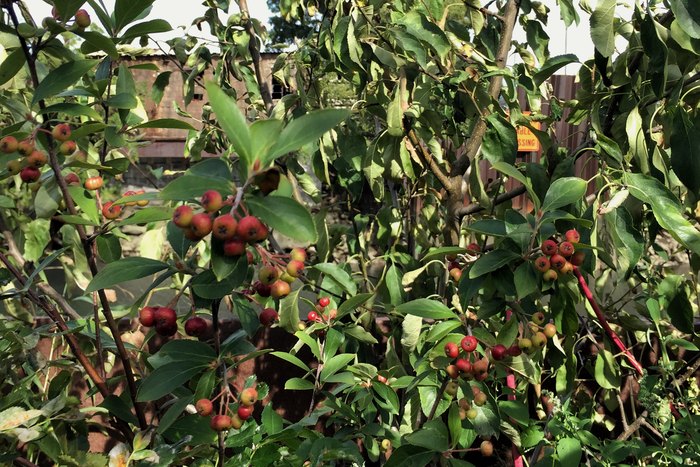
You are an artist, and quite recently, you went to France for a residency. What did you do there?
I got to research Monet’s gardens, how it’s being cared for and planted, and I made still lives there.
Did you need to switch to something differently in your head, like: Okay, now I’m in Monet’s garden and far away from Swale?
I think I wanted to understand what Monet’s gardens could bring to Swale. I spent a lot of time thinking about the aesthetics of Swale. Monet planted rows of colors that were slightly mixing, and they were positioned in a way that at sunrise, the gardens looked a certain way, and at sunset, they looked different. All the reds come out at sunset there, because of the way they are integrated with the purples and the yellows. I think we don’t really put this amount of detail into planting in the U. S., because, and I’m generalizing here, we think nature needs to be free to be. But in Monet’s garden, plants are not free to be (laughs), they are very directed. The result is over the top beautiful, it was like nothing I had ever seen. That made me think about about the sun and the direction that we are docked in with Swale, and about doing a little bit more training of the plants, about trellising and adding more edible flowers to the garden, so that people will have an added experience: Look, plants are seductive! You can pick from it, and yeah, it’s really hard to stop looking at it.
So next year this is going to be way more colorful?
We’ll see what the gardeners say to that. And Monet was a director and a perfectionist. And this is a social space, it’s not about perfection, it’s about learning together. So it will never be like what I experienced in France, but I have lots of ideas that I would like to see if people want to work with me to integrate them.
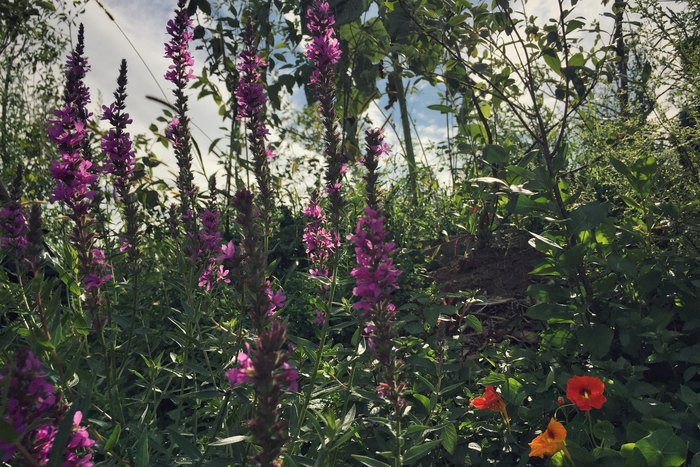
And now to the famous question: But is it art?
(laughs) It’s a provocation, so in that way, it’s art. It can also be seen in a space of experience: Sometimes you are moving with the water, sometimes you don’t even notice that you are on the water. But then at a certain angle, you see that you are floating. Both the multi-sensory experience and the provocation make Swale a piece of art. But all in all to frame it as art is pretty essential for this to happen in the city right now.
Why so?
People aren’t afraid of it when it’s art. Art is not as scary as activism to people. It’s a form of activism, but it’s also something else. So it plays with its idenity, and that allows for it to shapeshift, which essentially gives it more power and makes more people want to understand it. We use art as a platform.
Has that affected the way that you see yourself professionally?
It depends on the context. A lot of times I say that I am an artist and an organizer, but if I need to go into a meeting where we are looking for a certain type of funding, then I might also say that we are ecologists. We are able to change the frame for this. We need to. We need to get as many people involved as possible, and we need to keep it going financially.
So you wear many hats.
We do! I mean, we decide to call ourselves one thing just because this is the society we live in. We all wear many hats. How can you change policy with an artwork? Can you? No! It takes a lot of people doing different projects and a lot of momentum. And I think there is a lot of momentum here. It’s necessary here in the South Bronx, because this place is one of the biggest food deserts in the country. A lot of people are working on this subject in different ways here. And the more people do that, the harder it is to ignore that. So the city has to do something.
But then again, it’s hard to imagine 8.5 million people on barges …
… feeding themselves.
Right. So what do you want from this?
I want this to affect policy. If this project continues to go well, you can point to it whenever the city is thinking about how necessary it is to diversify food sources. New York’s Plan 2020 states that we need to be more resilient. And thinking about regeneration includes having more local options for food. Swale demonstrates one of these options. It’s not that one of those options is ever going to feed the entire city or even try to do that, but all of them can make an impact. So if a barge shows one of those options, and it’s working towards policy change where this could happen in the 30,000 acres of park space that New York City has, then that can have an impact. It is still not going to feed the whole city, but it’s going to make a dent in how much we draw from the outside, and it will make a big difference in health.
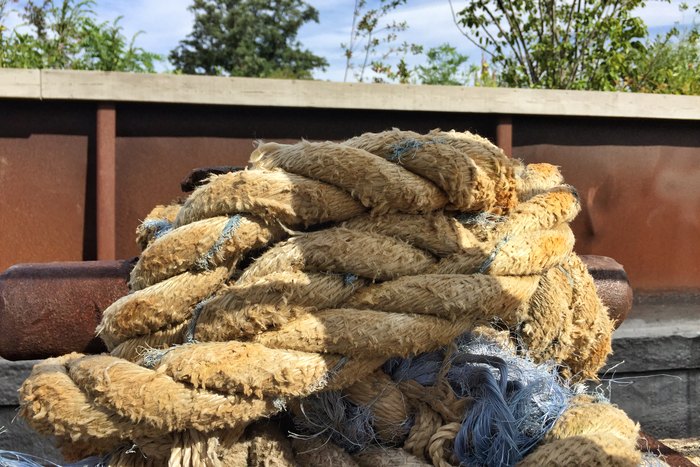
Swale will be docked at Concrete Plant Park until October 29th, 2017. You can visit – weather permitting – Friday to Sunday from 1-6pm. Find directions and details on the website.
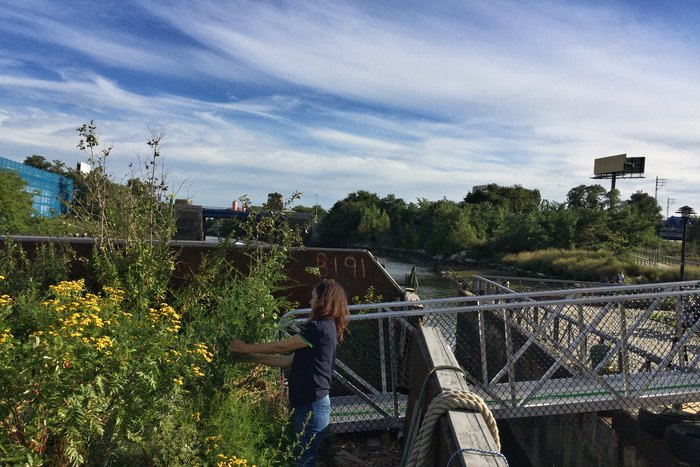
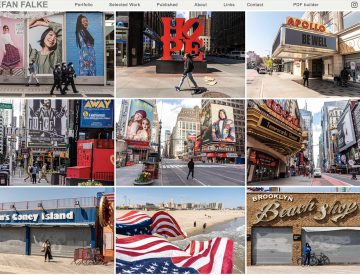
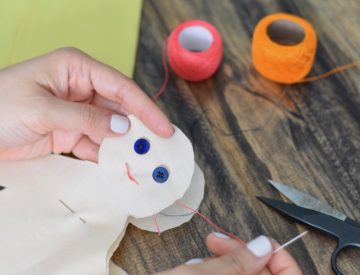
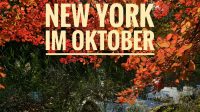
Lynn
September 25
I always love the idea of activism through art, but this is functional and educational in a much more tangible way. Spreading the word goes a long way with these under the radar causes. Love the in-depth post!
Petrina Engelke
September 25
Dear Lynn,
thank you so much, I’m glad you like it – especially since I was a little hesitant regarding the length of this post. And I agree, Swale is tangible, literally. :-) I hope you guys will get a chance to experience it yourselves before the barge goes upstate to hibernate.
Kind regards,
Petrina